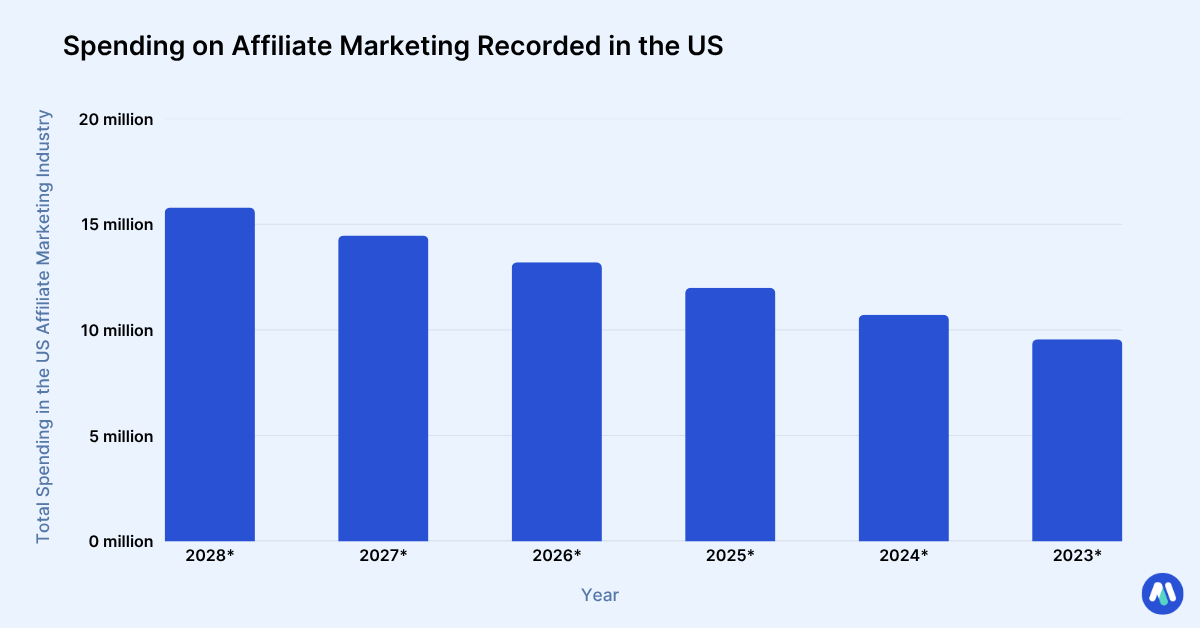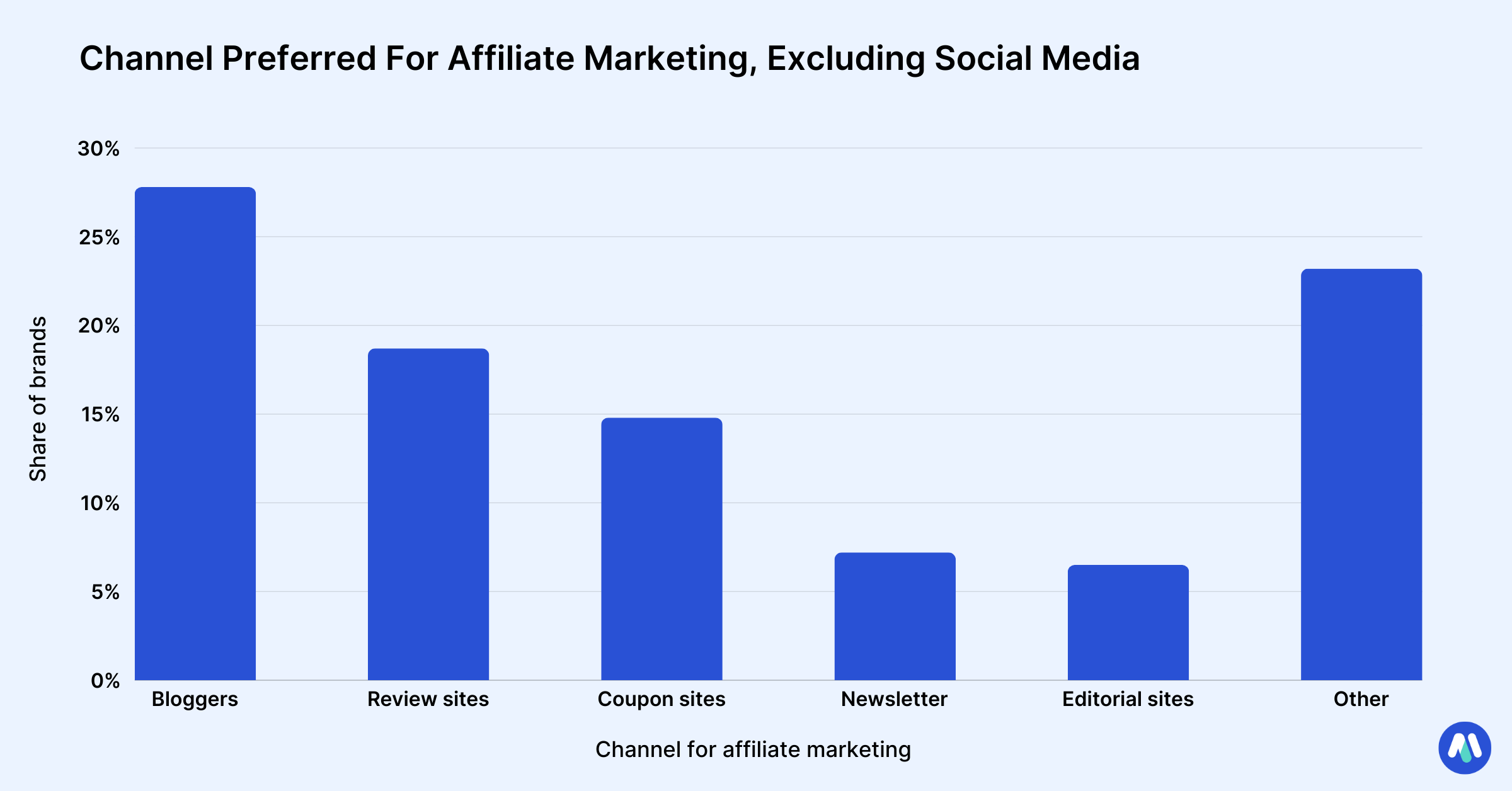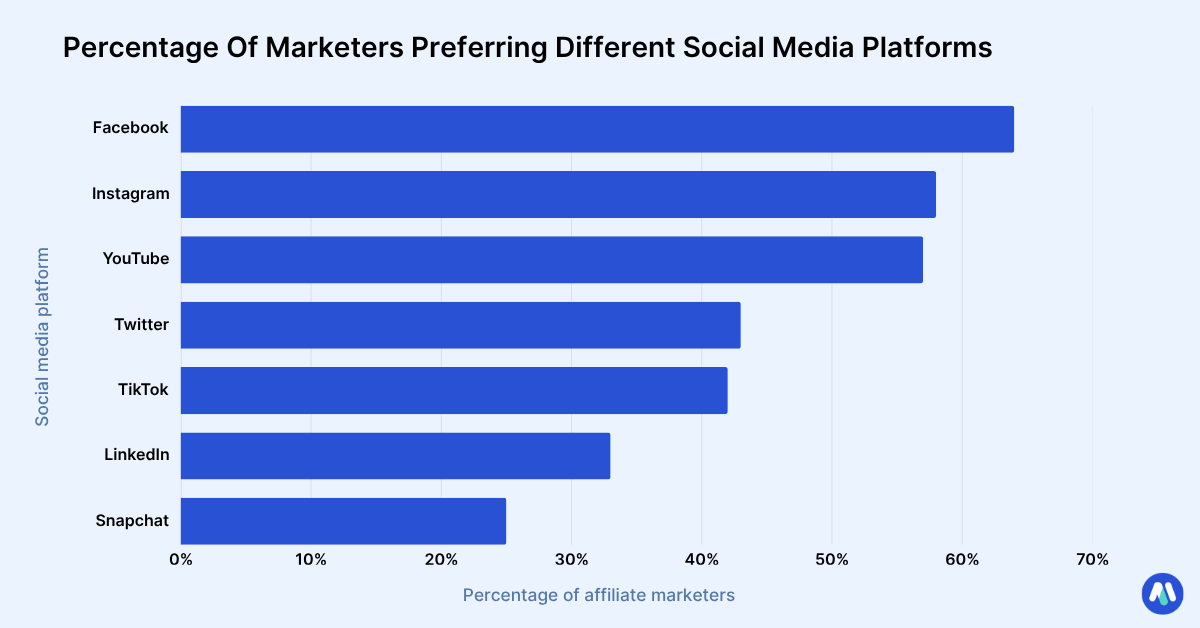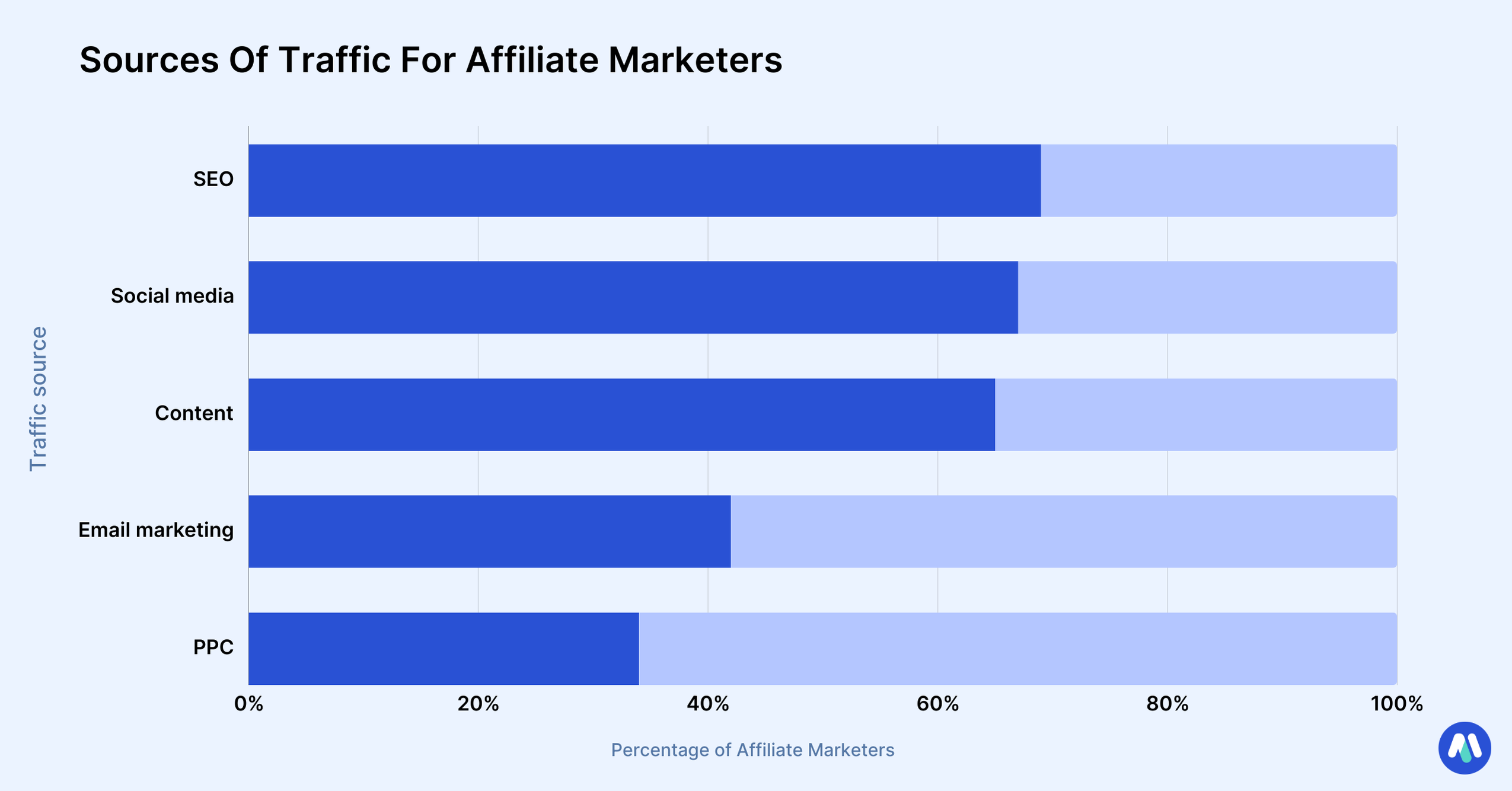Affiliate marketing spending is projected to exceed $10 billion by 2025. Additionally, the affiliate marketing industry is expected to reach a value of $31.7 billion by 2031.
Approximately 81% of brands utilize affiliate marketing programs to reach a broad audience and expand their business. Nothing less than that; the Software affiliate marketers generate an average of $5,967 per month.
Further in the article, I have covered all the details about the affiliate marketing industry, including its adoption by users and some facts that you might find interesting and helpful.
Top Affiliate Marketing Statistics (December 2025)
Discover the latest affiliate marketing statistics of 2025, along with key insights and trends shaping the digital landscape.
Affiliate Marketing Industry Statistics 2025
- The global affiliate marketing industry was valued at $18.5 billion in 2024 and is projected to reach $31.7 billion by 2031. (Source: Hostinger)
- As of 2025, affiliate marketing spending in the United States is estimated to reach approximately $11.99 billion.

The following table provides insights into the spending on affiliate marketing recorded in the United States.
| Year | Total Spending in the US Affiliate Marketing Industry | Percentage Increase from Previous Year |
|---|---|---|
| 2028* | $15.80 billion | 9.2% |
| 2027* | $14.47 billion | 9.6% |
| 2026* | $13.20 billion | 10.1% |
| 2025* | $11.99 billion | 11.9% |
| 2024* | $10.72 billion | 12.2% |
| 2023 | $9.56 billion | 13.7% |
Source: Emarketer
*- Estimated values
- Between 2023 and 2028, US affiliate marketing spending is expected to grow by 65%, rising from $9.56 billion to $15.80 billion.
- 2025 marks the first year that U.S. affiliate marketing spending is expected to cross $10 billion, reaching nearly $12 billion.
- 2025 marks the first year that US affiliate marketing spending will surpass $10 billion, reaching nearly $12 billion.
- On average, affiliate managers receive a commission ranging from 20% to 70% on SaaS-based products. (Source: Influencer Marketing Hub)
- Specifically, the Affiliate Marketing Software Market is projected to be valued at $ 2.1 billion by 2025. (Source: Future Market Insights)
Adoption of Affiliate Marketing by Businesses
- 81% of the brands use affiliate marketing programs. (Source: Rakuten)
- 31% of web publishers stated that affiliate marketing is their top revenue source. (Source: eMarketer)
- 65% of retailers report that their affiliate marketing programs have increased their annual revenue by up to 20%. (Source: Awin)
- 76% of publishers believe that affiliate marketing makes monetizing their website simple. (Source: Sovrn)
The following table displays the share of marketers with different experiences with their affiliate marketing programs.
| Success Rate | Percentage of Marketers |
|---|---|
| Highly Successful | 33% |
| Successful | 42% |
| Somewhat successful | 20% |
| Not Successful | 3% |
| Not at all successful | 2% |
- 81% of the brands said they use affiliate programs to boost sales and increase brand awareness.
- 94% of the publications utilize a number of affiliate programs.
- Over 5 billion clicks are recorded on affiliate marketing links annually.
- 5% to 25% of the overall sales of major brands come from affiliate marketing.
- Brands using affiliate marketing record an average ROI of $15 for every $1 spent. This equals a return of 1400% on affiliate marketing.
- 81% of the advertisers and 84% of the publishers use affiliate marketing.
- According to 28% of affiliate marketers worldwide, new, innovative marketing partners entering the channel are affiliate marketing’s unique strength.
At the same time, 27% of marketers stated that affiliate marketing is simple o manage and that it is one of the industry’s strengths.
The following table displays the strengths of affiliate marketing according to the affiliate marketers worldwide.
| Strength of Affiliate Marketing | Percentage of marketers |
|---|---|
| There are always new, innovative marketing partners entering the channel | 28% |
| The diverse variety of partner types available | 24% |
| It provides clear incremental value | 28% |
| It is simple to manage | 27% |
| It is highly flexible compared to other channels | 26% |
| It is an industry premised on personal relationships | 24% |
| It is a transparent ad channel that can be clearly tied to sales | 26% |
| It is a reliable source of revenue | 26% |
| It delivers a high return on investment (ROI) | 24% |
| Affiliate marketers can control the specific marketing outcomes | 25% |
- 50% of the marketers stated that affiliate marketing is an effective method for achieving business goals.
- On average, the affiliate marketing commission rate is between 5% and 30%.
- Excluding social media, blogging is the most used channel for affiliate marketing. 27.8% of the brands prefer blogs as a channel for affiliate marketing.
Meanwhile, 18.7% of brands prefer review sites as a channel for marketing their affiliate products, and just 6.5% prefer editorial sites.

| Channel for Affiliate Marketing | Share of Brands |
|---|---|
| Bloggers | 27.8% |
| Review sites | 18.7% |
| Coupon sites | 14.8% |
| Newsletter | 7.2% |
| Editorial sites | 6.5% |
| Other | 23.2% |
- 16% of the US ecommerce sales in the US and Canada come from affiliate marketing.
Source: Pepperjam, Statista, Forrester, Optin Monster, Authority Hacker
Affiliate Marketing Stats by Niche
- Education and eLearning, traveling, beauty, and skincare are the most profitable niches for affiliate marketing.
The average monthly income for affiliate marketers in the education and e-learning niche is $15,551, while that of the affiliate marketers in the travel niche is $13,847.
Conversely, parenting & family and personal development niches are less profitable niches for affiliate marketing. The marketers in these niches earn an average monthly income of $1,145 and $1,566, respectively.
The following table displays the average monthly income of affiliate marketers recorded in different niches.
| Niche | Average Commission Rates | Average Monthly Revenue |
|---|---|---|
| Software | 10-70% | $5,967 |
| Personal finance and investment | 20-40% | $9,296 |
| Health and wellness | 10-50% | $7,194 |
| eLearning | 15-30% | $15,551 |
| Travel | 10-15% | $13,847 |
| Beauty | 10-30% | $12,475 |
| Gadgets and electronics | 5-20% | $7,418 |
| Home improvement | 2-10% | $5,095 |
| Pet care | 2-20% | $920 |
| Sustainable products | 2-10% | $555 |
- On average, the potential earnings for the affiliate marketers in the education and Learning niche are expected to be $15,551.
At the same time, the potential earnings for Gaming and eSports and the technology niche is $12,475. Meanwhile, the Health and Wellness niche has an average monthly income of $8,038.
Source: Authority Hacker, Affiliate WP, Hostinger
Affiliate Marketer Statistics
- Over three-fourths of affiliate marketers prefer Facebook for affiliate marketing.
- Facebook is the most popular social media platform affiliate marketers use to promote their products. Instagram follows closely at 58%, while YouTube (57%) has emerged as a major player.
- When it comes to ROI, Facebook leads with 22% of marketers reporting that it delivers the best returns, followed by YouTube, Instagram, and TikTok, which are tied at 16% each.

The following table displays the percentage of marketers preferring different social media platforms for affiliate marketing.
| Social Media Platform | Percentage of Marketers Using Platform |
|---|---|
| 64% | |
| 58% | |
| YouTube | 57% |
| 43% | |
| TikTok | 42% |
| 33% | |
| Snapchat | 25% |
Source: Hubspot
- More than 56% of marketers increased their investment in TikTok.
- In 2023, 26% of marketers used TikTok for the first time, making it one of the fastest-growing platforms for affiliate promoters.
- Nearly 4 in 5 affiliate marketers are utilizing AI-driven content creation.
- Nearly 79.3% of affiliate marketers have adopted AI-driven content creation.
- 3% of affiliate marketers prefer to create videos for affiliate product promotions, while 90% of marketers using short-form video plan to increase or maintain their investment.
Source: Authority hacker, Hubspot
Demographics of Affiliate Marketers
- 81.82% of the affiliate marketers are aged between 25 to 54 years.
The majority of affiliate marketers are between 35 and 44 years old. At the same time, just 11.42% are above 55.
The following table displays the share of affiliate marketers that belong to different age groups as of 2016.
| Age Group | Share of Affiliate Marketers |
|---|---|
| Under 18 years | 0.29% |
| 18 to 24 | 5.08% |
| 25 to 34 | 27.55% |
| 35 to 44 | 31.86% |
| 45 to 54 | 22.41% |
| 55 to 64 | 8.67% |
| 65 or above | 2.75% |
| Prefer not to answer | 1.39% |
- 54% of the affiliate marketers are male, while 43% are female.
- 57% of affiliate marketers are from the United States, 10% are from Canada, and just 2% are from India.
- On average, affiliate marketers have about 2.8 years of experience.
Source: Statista, Authority Hacker
Affiliate Marketing Traffic Sources
- Over 50% of the affiliate traffic comes from mobile devices. (Source: Wix)
- Nearly 7 in 10 affiliate marketers stated that SEO is the top source of traffic.
Similarly, according to 67% of marketers, social media is the top channel to direct traffic to their affiliate links.

The following table displays the top sources of traffic for affiliate links according to the affiliate marketers.
| Traffic Source | Percentage of Affiliate Marketers |
|---|---|
| SEO | 69% |
| Social media | 67% |
| Content | 65% |
| Email marketing | 42% |
| PPC | 34% |
- On average, the monthly traffic recorded on the website of an affiliate marketer is 56,673 visitors.
- 35.5% of the affiliate marketers stated that they prefer to use organic social media traffic as the primary traffic source for their affiliate links.
- 22.8% of affiliate marketers use email marketing as a primary source of traffic for their affiliate marketing program.
- Marketers with over 6 years of experience rely 26.7% less on organic social media traffic than those with less experience.
- Over 17 in 20 affiliate marketers who use social media to drive traffic have less than 10,000 followers.
- On average, an affiliate marketer uses 3.02 social media platforms.
Source: Luisazhou, AWIN
Consumer Behaviour on Affiliate Marketing
- Influencers have inspired 88% of consumers to purchase through affiliate marketing campaigns.
- 90% of consumers make a purchase decision based on the reviews of the products they have come across.
- 74% of internet users visit a number of affiliate websites before making a purchase.
- 81% of the customers research a product online before going to the store and making a purchase.
- 38% of the customers stated that they trust an influencer’s affiliate links more than those of a non-influencer.
- 83% of the consumers stated that their shopping behavior may change according to the coupons.
- Approximately 56% of the affiliate content consists of product reviews, while 22% comprises how-to guides.
Source: Nielsen, Saleslion, WeCan Track, Inmar Intelligence
Challenges of Affiliate Marketing
- According to 9 in 20 affiliate marketers, the biggest challenge is getting traffic.
Meanwhile, over three in five affiliate marketers state that affiliate marketing fraud is the biggest challenge for them and the affiliate industry.
31.3% of the affiliate marketers stated that they have even considered giving up affiliate marketing.
Here is a table displaying further details about the challenges affiliate marketers face.
| Top Challenges | Percentage of Affiliate Marketers |
|---|---|
| Getting traffic | 45.3% |
| Search algorithm updates | 25.1% |
| Inadequate support from affiliate managers | 26.9% |
| Affiliate marketing fraud | 63% |
| Considered giving up affiliate marketing | 31.3% |
- 25.1% of the affiliate marketers were negatively affected by the search algorithm updates. Of these, 47.4% of the negatively impacted affiliate marketers stated that they changed their content strategy.
- 26.9% of marketers reported that their major challenge is inadequate support from the affiliate managers.
- 31.3% of the affiliate marketers who earn 6-plus figures annually reported that they have considered giving up affiliate marketing at some point.
- 40% of the media buyers in affiliate marketing stated that ad fraud is one of the biggest challenges they face.
Source: Saas Scout, Finances Online, AWIN, WeCanTrack
Miscellaneous Affiliate Marketing Statistics
- Amazon associates hold a 46.64% market share of the affiliate program market worldwide.
- It is the largest affiliate program worldwide, while the Rakuten affiliate Network is the second largest affiliate program worldwide, with a 7.70% share of the affiliate program market.
- Conversely, the AWIN affiliate program holds just a 6.88% share of the affiliate program market.
The following table displays the distribution of market share between different affiliate programs.
| Affiliate Program | Market Share (2024-2025) |
|---|---|
| Amazon Associates | 46.64% |
| Rakuten Affiliate Network | 7.70% |
| Awin | 6.88% |
| ShareASale | 6.27% |
| CJ Affiliate | 6.03% |
| Others | More than 26% |
Source: Datanyze
(Note: The data changes as there is a fluctuation in the affiliate industry and its programs.)
How Much Do Affiliate Marketers Make?
- Nearly 1 in 4 marketers earn between below $50K.
According to the influencer marketing hub, 57.55% of affiliate marketers earn below $10K annually, whereas 11.18% earn over $100K.
Just 3.78% of affiliate marketers earn over $150K annually, which represents the top earners in the industry.
Here is a table that displays the average annual revenue of affiliate marketers.
| Annual Revenue of Affiliate Marketers | Percentage of Affiliate Marketers |
|---|---|
| Over $150K | 3.78% |
| $100K to $150K | 7.40% |
| $50K to $100K | 5.15% |
| $10K to $50K | 16.21% |
| Below $10K | 57.55% |
| Undisclosed | 9.37% |
Source: Influencer Marketing Hub
- Affiliate marketers who have over three years of experience earn 9.45 times more than beginners.
- Nearly 7 in 10 affiliate marketing websites use advertisements as an additional monetization channel.
- According to 42.9% of marketers, affiliate marketing generates more revenue than ad monetization.
- 31.8% of content creators made below $500 through affiliate programs as of October 2023.
At the same time, 3.7% of affiliate marketers earn between $5,000 and $10,000.
The following table displays the social commerce earnings of creators through affiliate marketing as of December 2024.
| Earnings of Creators through Affiliate Marketing | Percentage of Creators |
|---|---|
| $0 to $100 | 8.4% |
| $100 to $500 | 23.4% |
| $500 to $1,000 | 13.1% |
| $1,000 to $5,000 | 28% |
| $5,000 to $10,000 | 3.7% |
| $10,000+ | 23.4% |
- The top coupon affiliate websites generate over $1 billion in revenue.
- Groupon, a well-known coupon website, generated a revenue of $599.09 million in 2022 through affiliate marketing.
Here is a table displaying the revenue generated by Groupon over the years.
| Year | Groupon Global Revenue |
|---|---|
| 2022 | $599.09 million |
| 2021 | $967.11 million |
| 2020 | $1,416.87 million |
| 2019 | $2,218.92 million |
| 2018 | $2,636.75 million |
| 2017 | $2,843.88 million |
| 2016 | $3,013.62 million |
| 2015 | $2,954.82 million |
| 2014 | $2,858.65 million |
| 2013 | $2,352.16 million |
| 2012 | $2,334.47 million |
Source: Wall Street Zen, eMarketer, Statista
Conclusion: Affiliate Marketing Industry Value Is Projected To Reach $31.7 Billion By 2031
Although the affiliate marketing industry’s value is estimated to reach $31.7 billion by 2031, it may even surpass that figure due to market trends in various industries.
Additionally, specifically in the United States, affiliate marketing spending is expected to exceed $11.99 billion by 2025. This is an 11.9% increase from the previous year.
All the data covered in this article shows the increase in affiliate marketing in terms of individual and industry-wise. The affiliate marketing statistics are expected to increase in the future due to increased user awareness, growing user interest, and more attractive industrial offers.